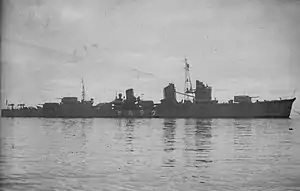 Urakaze on 15 December 1940 | |
| History | |
|---|---|
| Name | Urakaze |
| Ordered | 1937 |
| Builder | Fujinagata Shipyards, Osaka |
| Laid down | 11 April 1939 |
| Launched | 10 April 1940 |
| Commissioned | 15 December 1940 |
| Stricken | 10 January 1945 |
| Fate | Sunk by USS Sealion, 21 November 1944 |
| General characteristics | |
| Class and type | Kagerō-class destroyer |
| Displacement | 2,490 long tons (2,530 t) |
| Length | 118.5 m (388 ft 9 in) |
| Beam | 10.8 m (35 ft 5 in) |
| Draft | 3.8 m (12 ft 6 in) |
| Speed | 35 knots (40 mph; 65 km/h) |
| Complement | 240 |
| Armament |
|
Urakaze (浦風, "Wind on the Sea") was one of 19 Kagerō-class destroyers built for the Imperial Japanese Navy during the 1930s.
Design and description
The Kagerō class was an enlarged and improved version of the preceding Asashio class. Their crew numbered 240 officers and enlisted men. The ships measured 118.5 meters (388 ft 9 in) overall, with a beam of 10.8 meters (35 ft 5 in) and a draft of 3.76 meters (12 ft 4 in).[1] They displaced 2,065 metric tons (2,032 long tons) at standard load and 2,529 metric tons (2,489 long tons) at deep load.[2] The ships had two Kampon geared steam turbines, each driving one propeller shaft, using steam provided by three Kampon water-tube boilers. The turbines were rated at a total of 52,000 shaft horsepower (39,000 kW) for a designed speed of 35 knots (65 km/h; 40 mph). The ships had a range of 5,000 nautical miles (9,300 km; 5,800 mi) at a speed of 18 knots (33 km/h; 21 mph).[3]
The main armament of the Kagerō class consisted of six Type 3 127-millimeter (5.0 in) guns in three twin-gun turrets, one superfiring pair aft and one turret forward of the superstructure. They were built with four Type 96 25-millimeter (1.0 in) anti-aircraft guns in two twin-gun mounts, but more of these guns were added over the course of the war. The ships were also armed with eight 610-millimeter (24.0 in) torpedo tubes for the oxygen-fueled Type 93 "Long Lance" torpedo in two quadruple traversing mounts; one reload was carried for each tube.[2] Their anti-submarine weapons comprised 16 depth charges.[3]
Construction and career
On 9 June 1944, she rescued 126 survivors from the destroyer Tanikaze (including her commander Lieutenant Commander Ikeda) which had been sunk by the submarine USS Harder, near Tawitawi. During the Battle of Philippine Sea, she assisted survivors of the aircraft carrier Shōkaku, which was sunk by the submarine USS Cavalla, and slightly damaged the attacking submarine with depth charges.
On 21 November 1944, Urakaze was torpedoed and sunk with all hands - including Commander Destroyer Division 17 (Captain Tamotsu Tanii) - by the submarine USS Sealion,[4] 65 miles (105 km) north-northwest of Keelung, Formosa (26°09′N 121°23′E / 26.150°N 121.383°E). The torpedo that sank her was one out of three launched by the submarine, one of which inadvertently sank her with the two others missing their intended target, the battleship Nagato, and hitting the battleship Kongō, sinking her several hours later.
Notes
References
- Chesneau, Roger, ed. (1980). Conway's All the World's Fighting Ships 1922–1946. Greenwich, UK: Conway Maritime Press. ISBN 0-85177-146-7.
- Jentschura, Hansgeorg; Jung, Dieter & Mickel, Peter (1977). Warships of the Imperial Japanese Navy, 1869–1945. Annapolis, Maryland: United States Naval Institute. ISBN 0-87021-893-X.
- Whitley, M. J. (1988). Destroyers of World War 2. Annapolis, Maryland: Naval Institute Press. ISBN 0-87021-326-1.